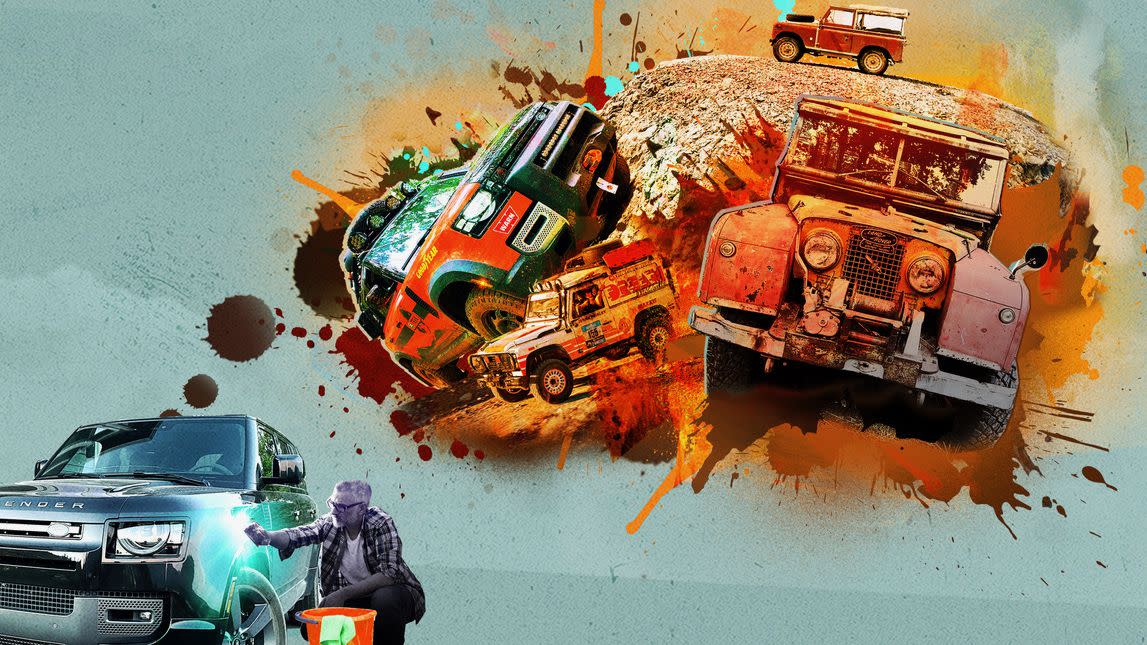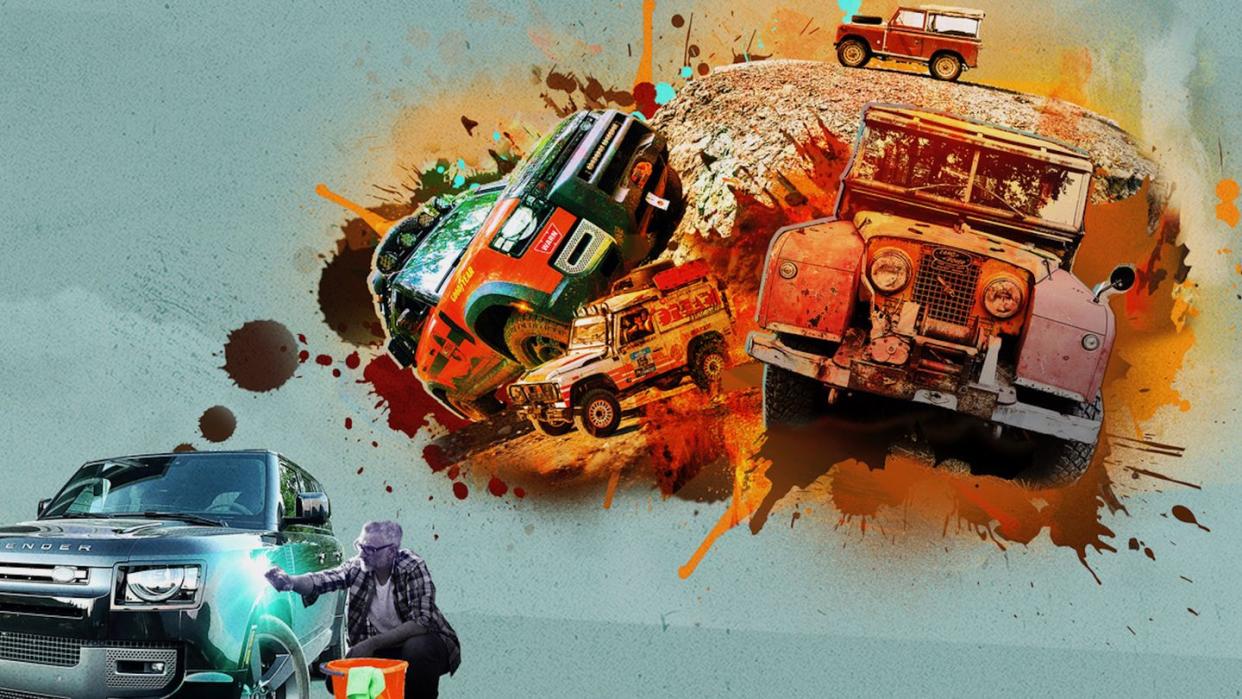Why Aren't You Getting Your Land Rover Dirty?


On a 20-acre plot in Springfield, Oregon, Land Rover restoration expert Ike Goss and his partner Jenna Fribley store a dozen classic Rovers of varying vintages. Goss’ workshop, Pangolin 4x4, is a few miles away; more Land Rovers, two Unimogs, and a Jaguar E-type hold court inside the warehouse.
This tract of land is untamed, just an unpaved road edged with a dodgy trench for future utility service; it's a forested playground with a fire pit and blackberry brambles, for now. The Rovers here are absolutely not show ponies, either; Goss and Fribley drive them hard, as they’re meant to be used. Fribley, a fellow Rebelle Rally off-road competitor, meets me at the campfire, happily dipping through ruts and crushing lumps in the dirt in her daily driver. It’s a faded 1966 SIIA 88-inch Station Wagon, named "Steadfast in Pursuit" by a previous owner.
As I roast sausages – and later, marshmallows – next to her classic truck, I start thinking about all the off-road-capable vehicles people have been snapping up in recent years – Ford Bronco, Jeep Grand Cherokee, Kia Telluride, Chevy Colorado ZR2, even the Hyundai Santa Cruz – and wonder how many of them never get to fulfill their raison d’etre. It's like buying a thoroughbred racing stallion and putting it in your pasture to look at it.
Where I live in Austin, every other vehicle is an SUV capable of a dirt road at the very least, and hardly anyone uses it that way, relegating their vehicles to Target runs. The most dirt they’ll see might be in a small puddle after a rain shower, quickly to be washed off. Don’t let the neighbors see that the SUV is dirty. Ew.
In defiance, I wheeled a new Land Rover Defender into the Gifford Pinchot National Forest in Washington this summer and dirtied it up as much as possible. That’s what you’re supposed to do in a Land Rover (or any 4x4, really): challenge it. That’s what it’s made to do. Why buy a rugged vehicle capable of tackling rough-and-tumble terrain and treat it like a Chevy Malibu?
The tide has begun to shift over the last few years toward more trails, campouts and overlanding. Still, judging from the drop-off line at the local middle school, some people need more incentive to tiptoe onto the dirt for the first time. The body (of the car) is willing even if the spirit (of the driver) is not… yet.
Rediscovering the outdoors from behind the windshield
In 2020, it was as if some giant, malevolent hand gripped the world and shook it like a snow globe. As the flecks settled back down to the ground, something was different. We found the outdoors again. Blinking, squinting against the sun, people emerged from their cubicles and looked away from their phones long enough to see that the Earth was still spinning.
And remembered there’s a lot to see. Between 400-plus national parks, 560 national wildlife refuges, plus roughly 250 million acres of public lands in the U.S., there is plenty of room to play in the dirt. In Nevada alone, the Bureau of Land Management oversees 48 million acres that are available to all.
Like some kind of revolution, Americans seemed to suddenly find overlanding. Then they pledged their hard-earned dollars toward accessorizing their vehicles to match their fever for the flavor of a 4x4. Ford, for one, noticed, and when the Bronco re-launched in 2020 it was available with more than 200 accessories in its catalog. Buyers could opt for rooftop tents, mini portable refrigerators, cargo racks, trail armor, and more for adventuring.
Plus, Ford invested millions of dollars into its four-location Off-Roadeo program, which teaches new Bronco owners how to use all the gadgets and G.O.A.T. modes and encouraged them to go out of their comfort zone. The amount of money the company is making from merchandise alone is paying off to the tune of $2.5 million in the last two years.
Even without a new Bronco in the driveway, opportunities to learn are abundant and easy to find with a keyboard. At the top end, Land Rover offers classes for $1,200 per vehicle. More affordable options include classes through Kansas Rocks Recreation Park, where experienced enthusiasts interested in sharing their knowledge teach off-roading 101 for $65. For next to nothing, newbies can find a forum or Facebook group and lurk until they’re brave enough to team up with other like-minded souls and venture out.
Through my job, I’ve learned how to drive capably off-road via dozens of driving events where Jeep Jamboree members and Ford Off-Roadeo staff guided me over sweat-inducing obstacles. Plowing through 1,500 miles of rocky, sandy, mountainous trails between Nevada and California for the Rebelle Rally honed my skills in new ways as well. Stopping on a dry lake bed to peer over my compass to figure out which direction to go with no street signs was almost eerie, in the best ways.
In 2021, Land Rover invited me to participate in its Trek competition (a tiny taste of its grueling Camel Trophy events of the past) against big-time competitors like Olympic skier Lindsey Vonn and high-altitude ski mountaineer Hilaree Nelson. Although I smashed my finger in the Defender door getting out of the vehicle on a hill to take my turn on the hi-lift jack, I reveled in the chance to get really, really sweaty and dirty.
This is what the Defender was born to do. And maybe I was, too.
Savoring the slow routes
Cora Jokinen bought Torq-Masters from its original owners almost a decade ago, and she’s seen the uptick in casual off-roading through sales of automatic locking differentials for the aftermarket automotive industry. Jokinen told me she has spoken with a lot of people who were new to off-roading and overlanding in the last three years.
“Walk-ins would say things like ‘I don’t know what I’m getting into, but I want to get the hell out of the city,’” she says.
Goss and Fribley often take Land Rover models that are 50-plus years old out on remote trails, and they’ve started flat-bedding the machines to their destination because grinding them down the highway isn’t as much fun as wheeling across national forests. Plus, Goss says, vintage Land Rovers don’t have much in the way of safety and comfort features anyway. These aren’t the plush Defenders like the one I drove through the Pacific Northwest, with heated seats and satellite radio and digital navigation. Not even close. But Goss doesn’t mind, because he believes the point of taking an old car on a trip is the journey itself.
“Getting off-road in a classic Land Rover forces you to stop in places you might not have stopped, and meet people you never would have met before,” Goss told me. “There’s an appeal in the unknown for some people; you might see something really amazing.”
The Land Rover enthusiast says he has a friend who drives an early-2000s Toyota pickup with a broken fuel gauge. Every once in a while, he runs out of gas and his wife reminds him to fix the gauge. Goss’ friend says he likes it just the way it is.
“Every time I run out of gas, I have an adventure,” he told Goss. “I meet someone new or go somewhere I’ve never been. It’s a different mindset that you can appreciate if you’re not in a hurry.”
He may get along well with the group of antique Model T owners who like to bop around off-road on original parts. That can’t possibly be a comfortable ride. But dang, it looks like fun. It’s worth noting that the gas tank in a Model Ts was located under the bench seat and the vehicle didn’t come with a gas gauge at all. Owners used a wooden ruler to measure how much was left in the tank.
Over the summer, my family traversed new routes across Oregon and Washington in the Defender and practiced our fly fishing, stumbled across sparkling waterfalls, and hiked to a mountain lake and didn’t see another soul for miles. Thirty minutes after leaving the primitive campground where we parked our SUV, we encountered a black bear (and I didn't pass out, happily). Each day, we packed a lunch and found a streamside rock, marveling at these places we’d never seen before.
The juxtaposition of and partnership between machines and nature is at its best on a road with no traffic, construction or stop lights. Go on, get your SUV dirty. Leave the mud splashes along the beltline as a badge of courage. A few pinstripes from thorny brush won’t hurt. And if you’re lucky, you might find a moment to catch your breath and look around to see what is dawning on more and more Americans as a gift.
You Might Also Like
